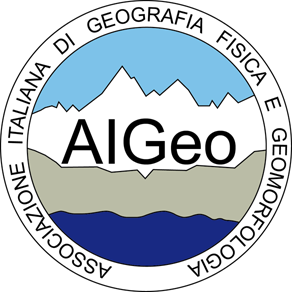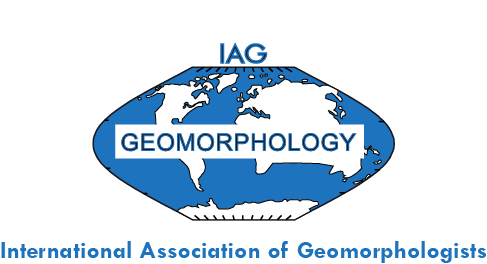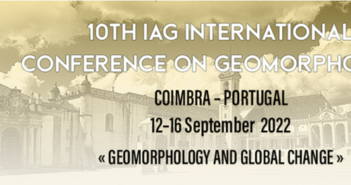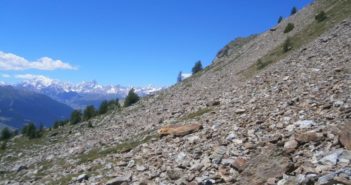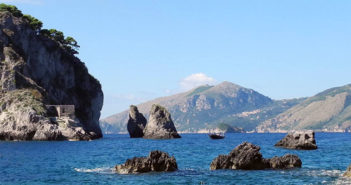COORDINATORI:
Francesco Troiani & Francesca Vergari
Sapienza Università di Roma
MISSIONE DEL GRUPPO DI LAVORO
Lo scopo principale delle attività di ricerca consiste nell’avanzamento metodologico della Geomorfologia quantitativa e teoretica. Sono stati individuati tre temi principali:
1) Messa a punto di metodi integrati di analisi dei volumi di materiale eroso, trasportato e depositato all’interno dei “sistemi di erosione fluviale” (sensu Strahler), tenendo conto della connettività del reticolo idrografico e del sistema versante/thalweg. Si desidera contribuire a investigare i processi che si verificano nella c.d. “Critical Zone”, estesa in verticale tra la copertura vegetale, il suolo e le acque superficiali e sotterranee. È in questo esiguo spessore, compreso tra l’atmosfera e la litosfera ed estremamente importante per l’umanità, che avviene la gran parte dei processi geomorfici: ci si propone perciò di organizzare una rete di aree-campione sperimentali sul territorio nazionale, dove raccogliere i dati, monitorare gli effetti dei processi di modellamento e misurare l’intensità dell’erosione. Si presterà attenzione alle informazioni relative agli aspetti ecologici, vegetazionali ed economici, data
l’importanza che questi hanno nelle relazioni di causa/effetto con i processi geomorfici. Si cercherà di ottenere quante più informazioni sulla dinamica degli eventi estremi e di operare una loro modellazione, poiché le ricerche finora condotte hanno mostrato che la quantità di materiale mobilizzato in poche ore nel corso di tali eventi può eguagliare o superare i valori di intensità dell’erosione media annua nei bacini di drenaggio.
2) Utilizzo dell’analisi geomorfica quantitativa per l’affinamento dei metodi di valutazione della pericolosità geomorfologica. Si intende procedere alla sperimentazione congiunta in aree dove i partecipanti abbiano già svolto studi di pericolosità per movimenti in massa, per inondazione fluviale e per erosione accelerata, applicando nuove tecniche di remote sensing e sviluppando nuovi parametri morfometrici, in grado di affiancare ed eventualmente di sostituire i classici fattori predisponenti i fenomeni sopra citati, usualmente utilizzati nei lavori di questo tipo. Lo scopo è quello di verificare se le caratteristiche geomorfologiche, espresse quantitativamente nel modo più completo possibile da una serie di parametri variegati, siano in grado di snellire le procedure di analisi, correlazione e zonazione spaziale, nonché di migliorare i metodi di valutazione delle pericolosità geomorfologiche, e quindi anche i prodotti cartografici finali.
3) Il terzo e ultimo tema rappresenta, allo stesso tempo, una finalità della Geomorfologia teoretica e uno strumento utile al raggiungimento degli scopi descritti nei precedenti punti 1) e 2). Ci si propone di operare una revisione sulle applicazioni in ambito geomorfologico di dati satellitari disponibili, su DEM di ultima generazione (es. lidar) e sugli strumenti, possibilmente open source, e in particolare di tipo GIS, per analizzare i dati. Ciò potrà rappresentare un supporto fondamentale per le successive analisi morfometriche dei reticoli idrografici, della superficie topografica, dei singoli morfotipi. Si intende procedere alla messa a punto e all’applicazione di metodi atti al riconoscimento automatico delle morfosculture e delle morfostrutture, nonché all’applicazione di metodi di analisi frattale. Si ritiene che tali studi non siano privi di potenziali ricadute applicative, che potranno essere di utilità a qualsiasi altro campo della ricerca geomorfologica e geografico-fisica.
MEMBRI:
| NOME E COGNOME | AFFERENZA | @ |
| Biolchi Sara | Università di Trieste | sbiolchi@units.it |
| Brandolini Pierluigi | Università di Genova | brando@unige.it |
| Capolongo Domenico | Università di Bari | domenico.capolongo@uniba.it |
| Ciccacci Sirio | Sapienza Università di Roma | sirio.ciccacci@uniroma1.it |
| Del Monte Maurizio | Sapienza Università di Roma | maurizio.delmonte@uniroma1.it |
| Della Seta Marta | Sapienza Università di Roma | marta.dellaseta@uniroma1.it |
| Devoto Stefano | Università di Trieste | stefano.devoto2015@gmail.com |
| Fredi Paola | Sapienza Università di Roma | paola.fredi@uniroma1.it |
| Furlani Stefano | Università di Trieste | sfurlani73@gmail.com |
| Giacchetta Emanuele | ETH Zurigo | emanuele.giachetta@erdw.ethz.ch |
| Gioia Dario | CNR-IBAM | d.gioia@ibam.cnr.it |
| Lupia Palmieri Elvidio | Sapienza Università di Roma | elvidio.lupiapalmieri@uniroma1.it |
| Maerker Michael | Università di Pavia | michael.maerker@unipv.it |
| Melelli Laura | Università di Perugia | laura.melelli@unipg.it |
| Molin Paola | Università di Roma 3 | p.molin@uniroma3.it |
| Piacentini Daniela | Università di Urbino | daniela.piacentini@uniurb.it |
| Piacentini Tommaso | Università di Chieti-Pescara | tpiacentini@unich.it |
| Polpetta Federica | Sapienza Università di Roma | federica.polpetta@gmail.it |
| Rotigliano Edoardo | Università di Palermo | edoardo.rotigliano@unipa.it |
| Saroli Michele | Università di Cassino | michele.saroli@unicas.it |
| Schiattarella Marcello | Università della Basilicata | marcello.schiattarella@unibas.it |
| Troiani Francesco | Sapienza Università di Roma | francesco.troiani@uniroma1.it |
| Valiante Mario | Sapienza Università di Roma | mario.valiante@uniroma1.it |
| Vergari Francesca | Sapienza Università di Roma | francesca.vergari@uniroma1.it |
| Zucca Francesco | Università di Pavia | francesco.zucca@unipv.it |
BIBLIOGRAFIA RECENTE
EROSION EVALUATION
AUCELLI P.C., CONFORTI M., DELLA SETA M., DEL MONTE M., D’UVA L., ROSSKOPF C.M., VERGARI F. (2014) – Multi-temporal digital photogrammetric analysis for quantitative assessment of soil erosion rates in the Landola catchment of the Upper Orcia Valley (Tuscany, Italy). Land degradation and development, published on line. DOI: 10.1002/ldr.2324
AUCELLI P.P.C., CONFORTI M., DELLA SETA M., DEL MONTE M., D’UVA L., ROSSKOPF C.M., VERGARI F. (2012). Quantitative assessment of soil erosion rates: results from direct monitoring and digital photogrammetric analysis on the Landola catchment in the Upper Orcia Valley (Tuscany, Italy). Rend. Online Soc. Geol. It., Vol. 21 (2012), pp. 1199-1201.
BENEDUCE P., DI LEO P., GIANO S.I. & SCHIATTARELLA M. (2012) – Quantitative geomorphic analysis of asbestos dispersion and pollution from natural sources: the case-history of the Pollino National Park, southern Italy. Geogr. Fis. Dinam. Quat., 35 (1), 3-12. DOI: 10.4461/GFDQ.2012.35.1
CALDARA M, CAPOLONGO D., DAMATO B. PENNETTA L. (2006) – Can the ground laser scanning technology be useful for coastal defenses monitoring? Italian Journal of Engineering Geology and Environment 1, 35-49.
CAPOLONGO D., DIODATO N., MANNAERTS C.M., PICCARRETA M., STROBL R.O. (2008) – Analyzing temporal changes in climate erosivity using a simplified rainfall erosivity model in Basilicata (southern Italy). Journal of Hydrology. DOI: 10.1016/j.jhydrol.2008.04.002
CEVASCO A., BRANDOLINI P., SCOPESI C., RELLINI I. (2013). Relationships between geo-hydrological processes induced by heavy rainfall and land-use: the case of 25 October 2011 in the Vernazza catchment (Cinque Terre, NW Italy). Journal of maps (ISSN:1744-5647), 289- 298 9(2)
CICCACCI S., GALIANO M., ROMA M.A., M. C. SALVATORE (2009) – Morphodynamics and morphological changes of the last 50 years in a badland sample area of Southern Tuscany (Italy). ZEITSCHRIFT FÜR GEOMORPHOLOGIE, vol. 53, p. 273-297, ISSN: 0372-8854, doi: 10.1127/0372-8854/2009/0053-0273
CICCACCI S., GALIANO M., ROMA M.A., SALVATORE M.C. (2008) – Morphological analysis and erosion rate evaluation in badlands of Radicofani area (Southern Tuscany – Italy). CATENA, vol. 74, p. 87-97, ISSN: 0341-8162, doi: 10.1016/j.catena.2008.03.012
CONOSCENTI C., AGNESI V., ANGILERI S., CAPPADONIA C., ROTIGLIANO E., MÄRKER M. A. (2013) – GIS-based approach for gully erosion susceptibility modelling: A test in Sicily, Italy. Environmental Earth Sciences 70/3, 1179-1195.
CONOSCENTI C., ANGILERI S., CAPPADONIA C., ROTIGLIANO E., AGNESI V., MÄRKER (2014) – M. Gully erosion susceptibility assessment by means of GIS-based logistic regression: A case of Sicily (Italy). Geomorphology 204, 399-411.
CONOSCENTI C., MAGGIO C., ROTIGLIANO E. (2008) – Soil erosion susceptibility assessment and validation using a geostatistical multivariate approach: A test in Southern Sicily. Natural Hazards 46/3, 287-305.
Della Seta M., Del Monte M., Fredi P. and Lupia Palmieri E. (2007): Direct and indirect evaluation of denudation rates in Central Italy. Catena, 71, 21-30. doi:10.1016/j.catena.2006.6.008
Della Seta, M., Del Monte, M., Fredi, P., Lupia Palmieri, E. (2008) – Space-time variability of denudation rates at the catchment and hillslope scales on the Tyrrhenian side of Central Italy. Geomorphology, doi: 10.1016/j.geomorph.2008.12.004
Del Monte M., E., Vergari, Brandolini P., Capolongo D., Cevasco A., Ciccacci S., Conoscenti C., Fredi P., Melelli L., Rotigliano F., Zucca F. (2014) – Multi-method evaluation of denudation rates in small Mediterranean catchments. In: G. Lollino et al. (eds.), Engineering Geology for Society and Territory – Volume 1, pp. 1-5, DOI: 10.1007/978-3-319-09300-0_105, © Springer International Publishing Switzerland 2014. Book ID: 326568_1_En Book ISBN: 978-3-319-09299-7. Chapter n. 105.
GIOIA D., GALLICCHIO S., MORETTI M., SCHIATTARELLA M. (2014) – Landscape response to tectonic and climatic forcing in the foredeep of the southern Apennines, Italy: insights from Quaternary stratigraphy, quantitative geomorphic analysis, and denudation rate proxies. Earth Surf. Process. Landforms (2014), Copyright © 2014 John Wiley & Sons, Ltd., Published online in Wiley Online Library (wileyonlinelibrary.com) DOI: 10.1002/esp.3544
LAZZARI M. & SCHIATTARELLA M. (2010) – Estimating long to short-term erosion rates of fluvial vs mass movement processes: an example from the axial zone of the southern Italian Apennines. Italian Journal of Agronomy, 5, 57-66.
M. GALIANO, S. CICCACCI (2011) – Recent morphoevolution of the Fabro calanchi badlands (Umbria, Italy). JOURNAL OF MEDITERRANEAN EARTH SCIENCES, vol. 3, p. 1-13, ISSN: 2037-2272, doi: 10.3304/JMES.2011.001
MAERKER M., DELLA SETA M., VERGARI F., DEL MONTE M. (2012). Process-Based Assessment of Erosion Dynamics in the Upper Orcia Valley (Southern Tuscany, Italy): A New Semi-Quantitative Integrated Approach. Rend. Online Soc. Geol. It., Vol. 21 (2012), pp. 1208-1211.
PICCARRETA M, CAPOLONGO D. (2009) – Global Change-induced Agricultural Runoff and Flood Frequency Increase in Mediterranean Areas: An Italian Perspective. Agricultural Runoff, Coastal Engineering and Flooding. ISBN/ISSN: 978-1-60741-097-3
PICCARRETA, M., CAPOLONGO, D., BOENZI, F. & BENTIVENGA, M. (2006) – Implications of decadal changes in precipitation and land use policy to soil erosion in Basilicata, Italy. Catena 65, 138–15.
PICCARRETA, M., CAPOLONGO, D., MICCOLI, M. N. & BENTIVENGA, M. (2012) – Global change and long-term gully sediment production dynamics in Basilicata, southern Italy. Environ. Earth Sci. 67, 1619–1630.
VERGARI F., DELLA SETA M., DEL MONTE M., PIERI L., VENTURA F. (2014). Integrated Approach to the Evaluation of Denudation Rates in an Experimental Catchment of the Northern Italian Apennines. In Lollino G, Manconi A, Clague J, Shan W, Chiarle M (Eds) Engineering Geology for Society and Territory Volume 1 Climate Change and Engineering Geology, Springer pp 533-537
VERGARI, F., DELLA SETA, M., DEL MONTE, M., BARBIERI, M. (2013). Badlands denudation “hot spots”: the role of parent material properties on geomorphic processes in 20-years monitored sites of Southern Tuscany (Italy). Catena, 106, 31-41, doi:10.1016/j.catena.2012.02.007
VERGARI, F., DELLA SETA, M., DEL MONTE, M., FREDI, P., LUPIA PALMIERI, E. (2013). Long- and short-term evolution of several Mediterranean denudation hot spots: The role of rainfall variations and human impact. Geomorphology, 183, 14-27 doi.org/10.1016/j.geomorph.2012.08.002.
HAZARD
BRANDOLINI P., CEVASCO A., FIRPO M., ROBBIANO A., Sacchini A. (2012). Geo-hydrological risk management for civil protection purposes in the urban area of Genoa (Liguria, NW Italy). NATURAL HAZARDS AND EARTH SYSTEM SCIENCES (ISSN:1684-9981), 943- 959 12
BRANDOLINI P., FACCINI F., NICCHIA P., TERRANOVA R. (2005). Dissesti geomorfologici, eventi alluvionali ed insediamenti antropici: il caso di Tribogna in Val Fontanabuona (Appennino ligure). GEOGRAFIA FISICA E DINAMICA QUATERNARIA, Supplementi vol. VII, p. 69-77, ISSN: 1724-4757
BRANDOLINI P., FACCINI F., ROBBIANO A., TERRANOVA R. (2007). Geomorphological hazard and monitoring activity in the western rocky coast of the Portofino Promontory (Italy). QUATERNARY INTERNATIONAL, vol. 171-172, p. 131-142, ISSN: 1040-6182
BRANDOLINI P., FACCINI F., ROBBIANO A., TERRANOVA R. (2008). Relationship between flood hazards and geomorphology applied to land planning in the upper Aveto Valley (Liguria, Italy). GEOGRAFIA FISICA E DINAMICA QUATERNARIA, vol. 31, p. 73-82, ISSN: 0391-9838
CAPOLONGO D., REFICE A., MANKELOW J. (2002) – Evaluating earthquake-triggered landslide hazard at the basin scale through GIS in the Upper Sele river Valley. Surv. Geophys. 23, 595-625.
CEVASCO A., PEPE G., BRANDOLINI P. (2012). Shallow landslides induced by heavy rainfall on terraced slopes: the case study of the October, 25, 2011 event in the Vernazza catchment (Cinque Terre, NW Italy). RENDICONTI ONLINE DELLA SOCIETÀ GEOLOGICA ITALIANA (ISSN:2035-8008), 384-386 21;
CEVASCO A., PEPE G., BRANDOLINI P. (2013). Geotechnical and stratigraphic aspects of shallow landslides at Cinque Terre (Liguria, Italy). RENDICONTI ONLINE DELLA SOCIETÀ GEOLOGICA ITALIANA (ISSN:2035-8008), 52-54 24;
CEVASCO A., PEPE G., BRANDOLINI P. (2013). The influences of geological and land-use settings on shallow landslides triggered by an intense rainfall event in a coastal terraced environment. BULLETIN OF ENGINEERING GEOLOGY AND THE ENVIRONMENT (ISSN:1435-9529), 1- 17
CONOSCENTI C., DI MAGGIO C., ROTIGLIANO E. (2008) – GIS analysis to assess landslide susceptibility in a fluvial basin of NW Sicily (Italy). Geomorphology 94, 325-339.
COSTANZO D., CAPPADONIA C., CONOSCENTI C., ROTIGLIANO E. (2012) – Exporting a Google Earth™ aided earth-flow susceptibility model: A test in central Sicily. Natural Hazards 61/1, 103-114.
COSTANZO D., CHACÓN J., CONOSCENTI C., IRIGARAY C., ROTIGLIANO E. (2013) – Forward logistic regression for earth-flow landslide susceptibility assessment in the Platani river basin (southern Sicily, Italy). Landslides, 1-15. Article in Press.
COSTANZO D., ROTIGLIANO E., IRIGARAY C., JIMÉNEZ-PERÁLVAREZ J.D., CHACÓN J. (2012) – Factors selection in landslide susceptibility modelling on large scale following the gis matrix method: Application to the river Beiro basin (Spain). Natural Hazards and Earth System Science 12/2, 327-340.
Del Monte M., Fredi P., Lupia Palmieri E., Marini R. (2002) – Contribution of quantitative geomorphic analysis to the evaluation of geomorphological hazards. In: Applied Geomorphology: Theory and Practice (Edited by R.J. Allison). John Wiley & Sons, Ltd, ch. 19, 335-358.
Della Seta, M., del Monte, M., Pascoli, A. (2005) – Quantitative geomorphic analysis to evaluate flood hazards. Geografia Fisica e Dinamica Quaternaria 28 (1), pp. 117-124
FACCINI F., BRANDOLINI P., ROBBIANO A., PERASSO L., SOLA A. (2005). Fenomeni di dissesto e precipitazioni estreme in rapporto alla pianificazione territoriale: l’evento alluvionale 2002 nella bassa val Lavagna (Liguria orientale). GEOGRAFIA FISICA E DINAMICA QUATERNARIA, Supplementi vol. VII, p. 145-153, ISSN: 0391-9838
FRANCIOSO R., GIANO S.I., LAPENNA V., RIZZO E., SCHIATTARELLA M. (2003) – Caratteri morfoevolutivi e valutazione dei distacchi potenziali di un versante in roccia nei pressi di San Chirico Raparo (Basilicata): applicazione integrata di metodi geologici e geofisici. Quaderni di Geologia Applicata, 10, 89-109.
GALVE JP., CEVASCO A., BRANDOLINI P., SOLDATI M. (2014). Assessment of shallow-landslide risk mitigation measures based on land use planning through probabilistic modelling. Landslides. In press . DOI 10.1007/s10346-014-0478-9
GIOIA D., DI LEO P., GIANO S.I., SCHIATTARELLA M. (2011) – Chronological constraints on a Holocene landslide in an intermontane basin of the southern Apennines, Italy: Morphological evolution and palaeoclimate implications. The Holocene, 21 (2), 263-273. DOI: 10.1177/0959683610378879
Liucci L., Melelli L., Suteanu C. (2014) – Scale-Invariance in the Spatial Development of Landslides in the Umbria Region (Italy). Pure and Applied Geophysics, Springer Basel, DOI 10.1007/s00024-014-0877-9.
Melelli L., Taramelli A. (2004) – An example of debris-flows hazard modeling using GIS.Natural Hazards and Earth System Sciences, 4(3), pp. 347-358. URL: http://www.nat-hazards-earth-syst-sci.net/4/347/2004/nhess-4-347-2004.pdf. SRef-ID: 1684-9981/nhess/2004-4-1.
Melelli L., Taramelli A. (2010) – Criteria for the elaboration of susceptibility maps for DGSD phenomena in central Italy. Geogr. Fis. Din. Quat., 33(2), 179-185, ISSN: 0391-9838.
Melelli L., Taramelli A., Alberto W. (2007) – Analisi combinata di dati ottici e radar per la stima della suscettibilità da deformazioni gravitative profonde di versante della Regione Piemonte. Rendiconti della Soc. Geol. It., 4, pp. 35-42.
Melelli L., Taramelli A., Nucci G. (2008) – L’analisi statistica bivariata in ambiente GIS: un esempio applicato alla valutazione della suscettibilità da frana.Mem. Descr. Carta Geol. D’It., LXXVIII (2008), pp.169-182. URL: http: //www.isprambiente.gov.it/files/pubblicazioni/periodicitecnici/memorie/memorielxxviii/memdes-78-melelli.zip.
MOSSA S., CAPOLONGO D., PENNETTA L., WASOWSKI J. (2005) – A GIS-based assessment of landsliding in the Daunia Apennines, Southern Italy. Polish Geol. Inst. Spec. Pap. 20, 86-91.
PACE F., CIARANFI N., BALDASSARRE G., MAGGIORE M., CAPOLONGO D., DE DONATO, FESTA V., FIORE A., GALLICCHIO S., MORETTI M., TILLI A., TROPEANO M.(2011) – Carta della Pericolosità per Franosità – Foglio 407 San Bartolomeo in Galdo, scala 1:50.000. ISPRA, Servizio Geologico d’Italia. ISBN: 9788824029919.
PASCALE S., PARISI S., MANCINI A., SCHIATTARELLA M., CONFORTI M., SOLE A., MURGANTE B., SDAO F. (2013) – Landslide Susceptibility Mapping Using Artificial Neural Network in the Urban Area of Senise and San Costantino Albanese (Basilicata, Southern Italy). Lecture Notes in Computer Science 06/2013; 7974 (IV), 473-488.
PIACENTINI D., SOLDATI M. (2008) – Application of empiric models for the analysis of rock-fall runout at a regional scale in mountain areas: examples from the Dolomites and the northern Apennines (Italy). Geografia Fisica e Dinamica Quaternaria 31/2, 215-223.
PIACENTINI D., TROIANI F., SOLDATI M., NOTARNICOLA C., SAVELLI D., SCHNEIDERBAUER S., STRADA C. (2012) – Geostatistical analysis for the assessment of shallow landslide susceptibility: the case study of the South Tyrol region (Eastern Alps). Geomorphology 151, 196-206.
PIGNATELLI C, FERILLI S, CAPOLONGO D, MARSICO A., MILELLA M, PENNETTA L, PISCITELLI A, MASTRONUZZI G (2010) – Evidenze morfologiche ed applicazioni informatiche al fine della valutazione del limite di inondazione da tsunami. Rivista Italiana di Telerilevamento 42, 129-142.
RAJABI A.M., KHAMEHCHIYAN M., MAHDAVIFAR M.R., DEL GAUDIO V., CAPOLONGO D. (2013) – A time probabilistic approach to seismic landslide hazard estimates in Iran. Soil Dyn. Earthq. Eng. 48, 25-34.
REFICE A., CAPOLONGO D. (2002) – Probabilistic modeling of uncertainties in earthquake-induced landslide hazard assessment. Comput. Geosci. 28, 735-749.
REFICE A., D. CAPOLONGO, G. PASQUARIELLO, A. D’ADDABBO, F. BOVENGA, R. NUTRICATO, F. P. LOVERGINE, L. PIETRANERA, “SAR and InSAR for flood monitoring: examples with COSMO-SkyMed data”, IEEE Journal of Selected Topics in Applied Earth Observations and Remote Sensing, 2014, accepted. DOI: 10.1109/JSTARS.2014.2305165
REFICE A., G. PASQUARIELLO, A. D’ADDABBO, F. BOVENGA, R. NUTRICATO, D. CAPOLONGO, A. LEPERA, L. PIETRANERA, S. MANFREDA, A. CANTISANI, A. SOLE, “Inundation monitoring through high-resolution SAR/InSAR data and 2D hydraulic simulations”, Proc. EARSeL 2013, Matera, Italy, 3-6 June 2013.
ROTIGLIANO E., AGNESI V., CAPPADONIA C., CONOSCENTI C. (2011) – The role of the diagnostic areas in the assessment of landslide susceptibility models: A test in the sicilian chain. Natural Hazards 58/3, 981-999.
ROTIGLIANO E., CAPPADONIA C., CONOSCENTI C., COSTANZO D., AGNESI V. (2012) – Slope units-based flow susceptibility model: Using validation tests to select controlling factors. Natural Hazards 61/1, 143-153.
SANTANGELO M., GIOIA D., CARDINALI M., GUZZETTI F., SCHIATTARELLA M. (2013) – Interplay between mass movement and fluvial network organization: An example from southern Apennines, Italy. Geomorphology, 188, 54-67. DOI: 10.1016/j.geomorph.2012.12.008
Taramelli A., Melelli L. (2007) – La valutazione della pericolosità da uragano in ambiente GIS: il caso dell’uragano Dennis su Cuba. Rendiconti della Soc. Geol. It., 4, pp. 27-34. URL: http://www.socgeol.net/download.php?id=37883.
Taramelli A., Melelli L. (2009) – Map of deep seated gravitational slope deformations susceptibility in central Italy derived from SRTM DEM and spectral mixing analysis of the Landsat ETM+ data. Int. Journal of Remote Sensing, 2, 30, 357-387, http://www.tandf.co.uk/journals.
Taramelli A., Melelli L., Pasqui M., Sorichetta A. (2010) – Modelling hurricane element at risk in potentially affected areas by GIS system. Geomatics, Natural Hazards and Risk, 1 (4), 349-373.
TROIANI F., GALVE J.P., PIACENTINI D., DELLA SETA M., GUERRERO J. (2014) – Spatial analysis of stream length-gradient (SL) index for detecting hillslope processes: a case of the Gállego river headwater (Central Pyrenees, Spain). Geomorphology. DOI: 10.1016/j.geomorph.2014.02.004.
VERGARI, F., DELLA SETA M., DEL MONTE M., FREDI P., LUPIA PALMIERI E. (2011). Landslide susceptibility assessment in the Upper Orcia Valley (Southern Tuscany, Italy) through conditional analysis: a contribution to the unbiased selection of causal factors. Natural Hazards and Earth System Sciences, 11, 1475-1497. doi:10.5194/nhess-11-1475-2011.
TECTONIC GEOMORPHOLOGY, GEOMORPHOMETRY
BAVUSI M., CHIANESE D., GIANO S.I. & MUCCIARELLI M. (2004) – Multidisciplinary investigations on the Grumentum Roman acqueduct (Basilicata, southern Italy). Annals of Geophyisics, 47(6), 1791-1801.
Belisario F., Del Monte M., Fredi P., Funiciello R., Lupia Palmieri E., Salvini F. (1999) – Azimuthal analysis of stream orientations to define regional tectonic lines. Fourth International Geomorphology Conference, Bologna. Zeitschrift fur Geomorphologie, Suppl.-Bd 118, 41-63.
CAPOLONGO D., CECARO G., GIANO S.I., LAZZARI M., SCHIATTARELLA M. (2005) – Structural control on drainage network of the south-western side of the Agri River upper valley (southern Apennines, Italy). Geogr. Fis. Dinam. Quat., 28, 169-180.
Cattuto C, Gregori L, Melelli L, Taramelli A, Troiani C. (2002) – Palaeogeographic evolution of the Terni basin (Umbria, Italy).Proceedings of the Scientific Meeting ‘Geological and geodynamic evolution of the Apennines’ in memory of Giampaolo Pialli, Foligno (PG) 16–17 February 2000. Bollettino della Societa` Geologica Italiana, Special Volume 1, pp. 865–872.URL http://www.socgeol.net/download.php?id=31653.
Cattuto C., Gregori L., Melelli L., Taramelli A. (2009) – La risposta del reticolo idrografico superficiale alla geometria dei sistemi di faglie: indicatori morfometrici da DEM e SRTM. Mem. Soc. Geol. It., LXXXVII, pp. 431-442.
Cattuto C., Gregori L., Melelli L., Taramelli A., Broso D. (2005) – I conoidi nell’evoluzione delle conche intermontane umbre. Geogr. Fis. Dinam. Quat. Suppl. VII (2005), 89-95. URL http://gfdq.glaciologia.it/sgfdq_vii_12_2005/.
Ciotoli G., Della Seta M., Del Monte M., Fredi P., Lombardi S., Lupia Palmieri E. and Pugliese F. (2003) – Morphological and geochemical evidence of neotectonics in the volcanic area of Monti Vulsini (Latium, Italy). Quaternary International, 101-102 (2003), 103 -113.
DEL MONTE M, P. FREDI, LUPIA PALMIERI E, SBARRA P (2007). Some Relations between Fractal Dimension of Drainage Networks and Geomorphology of Drainage Basins. TRANSACTIONS JAPANESE GEOMORPHOLOGICAL UNION, vol. 28 (1), p. 1-21, ISSN: 0389-1755.
DELLA SETA M.; DEL MONTE M.; FREDI P.; PALMIERI E.L.; SBARRA P. (2005) – Fractal analysis and morphological evolution of vulcanic relief:some examples from Italy”, Zeitschrift für Geomorphologie. Supplementband, 140, 2005, pp. 1-18.
GIANO S.I. & SCHIATTARELLA M. (2014) – Age constraints and denudation rate of a multistage fault line scarp: an example from southern Italy. Geochronometria, available online at www.springerlink.com, DOI 10.2478/s13386-013-0158-x
GIANO S.I., GIANNANDREA P. (2014) – Late Pleistocene differential uplift inferred from the analysis of fluvial terraces (southern Apennines, Italy). Geomorphology, 217, 89-105. DOI 10.1016/j.geomorph.2014.04.016.
GIANO S.I., GIOIA D., LAURENZI M.A., SCHIATTARELLA M. (2014) – Nuovi vincoli su età, entità e velocità delle dislocazioni quaternarie nell’area del Vallo di Diano (Appennino meridionale). Atti del Convegno “Dialogo intorno al Paesaggio”, Culture Territori Linguaggi, Perugia, in stampa
GIANO S.I., MASCHIO L., ALESSIO M., FERRANTI L., IMPROTA S., SCHIATTARELLA M. (2000) – Radiocarbon dating of active faulting in the Agri high valley, southern Italy. Journ. Geodynamics, 29, 371-386.
GIOIA D. & SCHIATTARELLA M. (2010) – An alternative method of azimuthal data analysis to improve the study of relationships between tectonics and drainage networks: examples from southern Italy. Zeit. Geomorph., 54 (2), 225-241.
MARTINO C., NICO G. & SCHIATTARELLA M. (2009) – Quantitative analysis of InSAR Digital Elevation Models for identification of areas with different tectonic activity in southern Italy. Earth Surface Processes and Landforms, 34, 3-15. DOI: 10.1002/esp.1681
Melelli L. (2014) – Geodiversity: a new quantitative index for natural protected areas enhancement. GeoJournal of Tourism and Geosites ISSN 2065-0817, E-ISSN 2065-1198. VII, no. 1, vol. 13, May 2014, p. 2-12 Article no. 13103-142.
Melelli L., Pucci S., Saccucci L., Mirabella F., Pazzaglia F., Barchi M.R., (in press) – Morphotectonics of the Upper Tiber Valley (Northern Apennines, Italy), through quantitative analysis of drainage and landforms. Rendiconti Lincei – Scienze Fisiche e Naturali.
Mirabella F., Barchi M., Brozzetti F., Lupattelli A., Melelli L., Saccucci L., Pazzaglia F., Pucci S. (2010) – Morphotectonic evolution of a Quaternary basin driven by a segmented low-angle extensional system. Rendiconti Online della Società Geologica Italiana, ISSN2035-8008.
Pucci S., Mirabella F., Pazzaglia F., Barchi M., Melelli L., Soligo M., Tuccimei P., Saccucci L. (under review) – Quaternary interaction between regional and local tectonic forcing along a complex extensional basin: the Upper Tiber Valley (Northern Apennines, Italy). Quaternary International. Elsevier Ed.
Pucci S., Mirabella F., Pazzaglia F., Barchi M.R., Melelli L., Tuccimei P., Soligo M., Saccucci L. (2014) – Interaction between regional and local tectonic forcing along a complex Quaternary extensional basin: Upper Tiber Valley, Northern Apennines, Italy. Quaternary Science Reviews, 102, 111-132. http://dx.doi.org/10.1016/j.quascirev.2014.08.009 0277-3791.
Taramelli A. Melelli L. (2009) – Detecting alluvial fans using quantitative roughness characterization and fuzzy logic analysis using the Shuttle Radar Topography Mission data. Int. J. of Computer Sc. and Software Techonolgy, vol. 2, n. 1, January-June 2009, pp. 55-67. © Int. Sc. Press, ISSN:0974-3898.
TROIANI F., DELLA SETA M. (2008) – The Use of the Stream Length-Gradient Index in morphotectonic analysis of small catchments: a case study from central Italy. Geomorphology, 102/1, 159-168.
TROIANI F., DELLA SETA M. (2011) – Geomorphological responses of fluvial and coastal terraces to late Quaternary tectonics and climate change as revealed by geostatistic topographic analysis. Earth Surface Processes and Landforms, 36, 1193-1208.
